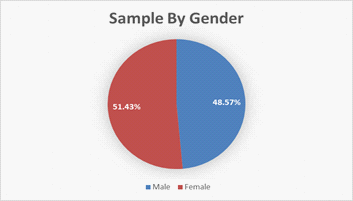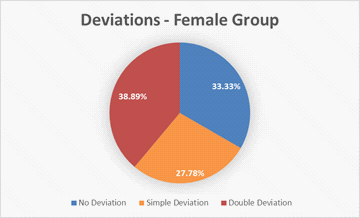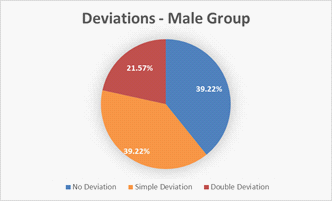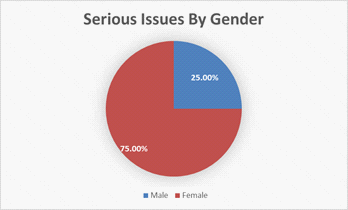Abstract
In Romania, scoliosis is a formidable health issue among children and youth, its current incidence being at 2-3%. We consider that this condition is but underdiagnosed, many scoliotic postures remaining unnoticed in early stages, when, using only conservative methods, such as kinesiology supported by orthotics (i.e. wearing a corset adapted to the respective spine deviation), its evolution can be stopped or even reversed – the deviation angle displaying a considerable, in some instances, decrease. Through this paper we aim to point out the importance of regular screenings in school aged children (both in primary and secondary school) in order to identify cases displaying scoliotic deficiencies with a potential for aggravation. The experiment – conducted in May 2012 – consisted in the somatoscopic evaluation of 105 subjects aged 9-11, studying in the IVth grade in a primary school in Bucharest. The sample consisted of the IVth grade students that were present at school during the day – the subjects were screened at location by the author following faculty and parental approval in order to identify scoliotic tendencies and the types thereof. Following collection and data analysis, we identified a total of 67 students with scoliotic postures, of which 32 with double curvature. Gender-wise, we observed a higher incidence of scoliosis in female subjects, although the differences were not very large. Instead, a significantly higher number of dual curve scoliotic deviations in females was noted.
Keywords: Somatoscopychildrenscoliosis
1.Introduction
Scoliosis is the most formidable deviation of the spine considering its biomechanical impact, such
as respiratory, cardiovascular, aesthetic, psychological, etc.
In Romania, scoliosis is a formidable health issue among children and youth, its current incidence
being at 2-3%. We consider that this condition is but underdiagnosed, many scoliotic postures remaining
unnoticed in early stages, when, using only conservative methods, such as kinesiology supported by
orthotics (i.e. wearing a brace adapted to the respective spine deviation), its evolution can be stopped or
even reversed – the deviation angle displaying a considerable, in some instances, decrease.
Scoliosis can be classified by several criteria: cause, age of incipience, deviation size, the number
of curves, severity evolution etc. (Baaj, 01.20.2017, Lenke, L.G.2001).
Since minor spine deviations on the side of the dominant upper limb will occur ubiquitously, only
deviations exceeding 10º will be considered as scoliosis. (Asher, Burton, 2006).
In 90% of cases, the disease is idiopathic or primary, without an identifiable cause or a trigger
mechanism. "The remaining 2-3% of cases occur from birth due to malformations of the vertebrae or ribs
and 6-7% are due to other causes - neuromuscular disease, neurofibromatosis, cerebral palsy" (Jianu,
2014, 2001).
2.Problem Statement
Through this paper we aim to point out the importance of regular screenings in school aged
children (both in primary and secondary school) in order to identify cases displaying scoliotic deficiencies
with a potential for aggravation.
3.Research Questions
Which is the incidence of scoliosis in children in Romania?
Which are the most affected subjects by scoliosis?
4.Purpose of the Study
The aims of this evaluation are the following:
- To assess general and segmental alignment of the body,
- To assess the proportionality of body segments,
- Observe deviations from normal posture,
- To establish the objectives of the recovery and physical therapy treatment,
- After starting the recovery therapy, to observe the issue’s evolution and the therapy’s
effectiveness.
5.Research Methods
Somatoscopy is the visual examination of the human body (Cordun, 1999), in frontal, posterior
and lateral incidences, at rest and in motion. „The importance of visual observations cannot be
undermined in the study of somatometry. Although these visual observations are not very accurate, still
they are indispensable in somatometry” (Sarkar, 2016).
Directly derived from inspection - a method belonging to medical clinical examination,
somatoscopy has been challenged in recent years with the advent of a more precise diagnostic methods
for spine bias assessment. We believe that somatoscopy retains its value in screening-type investigations,
where a large number of subjects is to be evaluated, but cannot be moved to a specialized laboratory.
The aims of this evaluation are the following:
- To assess general and segmental alignment of the body,
- To assess the proportionality of body segments,
- Observe deviations from normal posture,
- To establish the objectives of the recovery and physical therapy treatment,
- After starting the recovery therapy, to observe the issue’s evolution and the therapy’s
effectiveness.
Once a spinal deviation is observed, complex both instrumental and radiological tests will be
conducted (Tyagur, 2014).
Early diagnosis of scoliosis is of the utmost importance, as there are correlations between its
presence and vascular, cardiovascular and kidney disorders. Noting the curves of over 10º in children
under ten, or over 20º in children 10 years or older, requires further investigation and monitoring
(Janicki&Alman, 2007).
The main drawback of the somatoscopic method is being unable to tell the severity of the spinal
deviation and to highlight the magnitude of vertebral rotation.
The experiment – conducted in May 2012 – consisted in the somatoscopic evaluation of 105
subjects aged 9-11, studying in the IVth grade in a primary school in Bucharest. The sample consisted of
the IVth grade students that were present at school during the day – the subjects were screened at location
by the author following faculty and parental approval in order to identify scoliotic tendencies and the
types thereof.
6.Findings

The evaluated group was comprised of 54 girls (51.4%) and 51 boys (48.6%) (figure
105 evaluated subjects, a total of 67 displayed upper spine deviations, of which 36 girls and 31 boys.
In the female group, the following were identified:
- 15 simple curvature deviations with reduced amplitude - 8 right and 7 left;
- 21 double curvature deviations, of which 15 right and 6 left, 3 of them being grave, with
vertebral rotation determining costal imbalance (figure

In the male group, the following were identified:
- 20 simple curvature deviations, 2 right and 18 left;
- 11 double curvature deviations with 8 right and 3 left; only in 1 case a coastal imbalance (curved
back) was observed (figure

The group was comprised of 54 girls, representing 51.4% and 51 boys, representing 48.6%. (Fig.
no 1)
36 cases of spinal deviation was observed in females, of which 21 (58%) that could evolve into
more serious forms.
31 cases of spinal deviation was observed in males, of which 11 (35%) that could evolve into more
serious forms.
The total number of subjects who spinal deviations is 67, representing 63%.
The number of serious cases, with vertebral rotation is 3 in the girls’ group and 1 in the of boys’
group.

7.Conclusion
In the 9-11 years age group, in which the sample is included, many children have small amplitude
spine deviations, known as scoliotic attitudes.
By comparing groups of girls with boys, there is a greater number of disorders with higher risk
of development in the female group (figure
In the female group we encountered 3 cases of structural scoliosis, which have already initiated
the process of vertebral rotation, which means a rate of 5.76% of all girls.
In the male group a single case of structural scoliosis was found, which which accounts for
1.96%.
The number of cases of structural scoliosis is 4, which means 3.8% in respect to the total number
of evaluated students, a value which, unfortunately, is near the official statistics (2-3%), which ranks
Romania first in Europe for the incidence of scoliosis.
We want the study to reveal the need for this type of screening at school cycles’ ends, in order to
detect early any possible cases with increased risk of evolution, so that kinetic treatment, as a mean to
prevent scoliosis, could be started.
References
- Asher, M.A., Burton, D.C. (2006) Adolescent idiopathic scoliosis: natural history and long term treatment effects. Published: 31 March 2006. In https://scoliosisjournal. biomedcentral. com/articles /10.1186/1748-7161-1-2//12.07.2016;
- Baaj, A. (2017) Scoliosis: What You Need to Know. In: http://www.spine-health.com/conditions /scoliosis/scoliosis-what-you-need-know//accessed 05.03.2017;
- Cordun, M. (1999) Kinetologie medicală. București: Editura Axa;
- Janicki, J.A., Alman, B. (2007) Scoliosis: Review of diagnosis and treatment. In: Journal List Paediatr Child Health. 12(9); 2007 Nov 771-776;
- Jianu, M. (2001) Tratamentul scoliozei la copil si adolescent. București: Editura Cartea Românească;
- Jianu, M. (2014) Noțiuni practice de ortopedie pediatrică de la nou-născut la adolescent. București: Pro Editura si tipografie;
- Lenke, L.G., Edwards, C.C., Bridwell, K.H. (2003). The Lenke Classification of Adolescent Idiopathic Scoliosis: How it Organizes Curve Patterns as a Template to Perform Selective Fusions of the Spine. In: Spine. 15 October 2003 - Volume 28 - Issue 20, 199-207// http://journals.lww.com /spinejournal/Abstract/2003/10151/The_Lenke_Classification_of_ Adolescent_Idiopathic.15.aspx (accessed 15.03.2017);
- Sarkar, J. (2016) Study of Somatoscopy: 22 Somatoscopy Techniques to Study Various Parts of Human Body. in http://www.yourarticlelibrary.com/essay/anthropology/study-of-somatoscopy-22-somatoscopy -techniques-to-study-various-parts-of-human-body/ 41840//(accessed 04.03.2017);
- Tyagur, T. (2014) Principles of Modern Methods of Diagnosis of Scoliosis. In: Eur Spine J. 2011 Jan; 20(1): 135–143. doi: 10.1007/s00586-010-1566-8//(accessed 11.01.2017); .
Copyright information

This work is licensed under a Creative Commons Attribution-NonCommercial-NoDerivatives 4.0 International License.
About this article
Publication Date
12 June 2017
Article Doi
eBook ISBN
978-1-80296-023-5
Publisher
Future Academy
Volume
24
Print ISBN (optional)
-
Edition Number
1st Edition
Pages
1-91
Subjects
Sports, sport science, physical education
Cite this article as:
Buhociu, E. (2017). Somatoscopy – An Easy Way To Identify School Aged Subjects At High Risk To Develop Scoliosis. In E. Lupu, G. Niculescu, & E. Sabău (Eds.), Sport, Education & Psychology - icSEP 2017, vol 24. European Proceedings of Social and Behavioural Sciences (pp. 61-66). Future Academy. https://doi.org/10.15405/epsbs.2017.06.8

